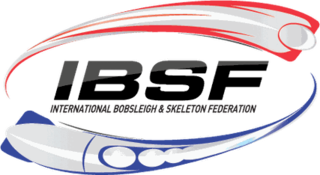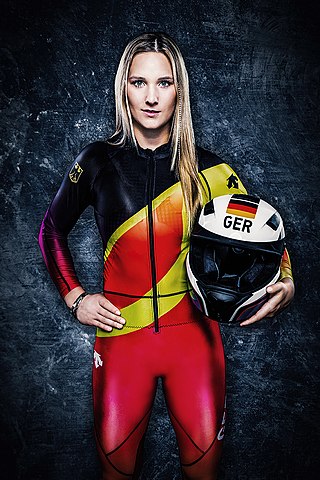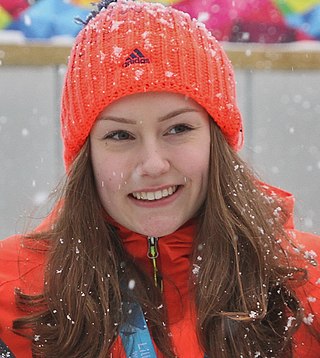
Bobsleigh or bobsled is a winter sport in which teams of 2 to 4 athletes make timed runs down narrow, twisting, banked, iced tracks in a gravity-powered sleigh. International bobsleigh competitions are governed by the International Bobsleigh and Skeleton Federation.

The 1948 Winter Olympics, officially known as the V Olympic Winter Games and commonly known as St. Moritz 1948, were a winter multi-sport event held from 30 January to 8 February 1948 in St. Moritz, Switzerland. The Games were the first to be celebrated after World War II; it had been twelve years since the last Winter Games in 1936.

The 1928 Winter Olympics, officially known as the II Olympic Winter Games and commonly known as St. Moritz 1928, were an international winter multi-sport event that was celebrated from 11 to 19 February 1928 in St. Moritz, Switzerland.

Skeleton is a winter sliding sport in which a person rides a small sled, known as a skeleton bobsled, down a frozen track while lying face down and head-first. The sport and the sled may have been named from the bony appearance of the sled.

Sledding, sledging or sleighing is a winter sport typically carried out in a prone or seated position on a vehicle generically known as a sled, a sledge (British), or a sleigh. It is the basis of three Olympic sports: luge, skeleton and bobsledding. When practised on sand, it is known as a form of sandboarding. In Russia sledges are used for maritime activities including fishing and commuting from island to island on ice.
Major Thomas "Robin" Valerian Dixon, 3rd Baron Glentoran,, is a former British bobsledder and Northern Irish politician, known as Robin Dixon. He is a former Conservative Party Shadow Minister for the Olympics.

The International Bobsleigh and Skeleton Federation (IBSF) is the international sports federation for the sliding sports of Bobsleigh and Skeleton. It was founded on 23 November 1923 by the delegates of Great Britain, France, Switzerland, Canada, and the United States at the meeting of their first International Congress in Paris, France. In June 2015, it announced a name change from FIBT to IBSF. The federation's headquarters are in Lausanne, Switzerland.
Antony James Dillon Nash MBE was a British bobsledder, born in Amersham, who competed in the 1960s. Competing in two Winter Olympics, he won the gold in the two-man event at the 1964 Winter Olympics in Innsbruck.

The Königssee bobsleigh, luge, and skeleton track is a venue in Germany for bobsleigh, luge and skeleton, located in Schönau am Königssee, Bavaria, near Königssee and the border with Austria. Completed 56 years ago in 1968, it is the first permanent, artificially refrigerated bobsleigh, luge, and skeleton track in the world. In July 2021, the track was severely damaged by the floods that affected the European continent, and is currently under reconstruction.

The Mt. Van Hoevenberg Olympic Bobsled Run is a venue for bobsleigh, luge and skeleton in the United States, located at the Lake Placid Olympic Sports Complex in Lake Placid, New York. This venue was used for the 1932 and 1980 Winter Olympics and for the only winter Goodwill Games in 2000. The track hosted both the first FIBT World Championships and FIL World Luge Championships held outside of Europe, doing so in 1949 and 1983. The third and most recent version of the track was completed in 2000. In 2010 the bobsled track was listed on the National Register of Historic Places.

The Eugenio Monti Olympic Track was a bobsleigh and skeleton track located in Cortina d'Ampezzo, Italy. It was named after Eugenio Monti (1928–2003), who won six bobsleigh medals at the Winter Olympic Games between 1956 and 1968 and ten medals at the FIBT World Championships between 1957 and 1966. It was featured in the 1981 James Bond film For Your Eyes Only, held after the 1981 FIBT World Championships, before the track was shortened to its current configuration. In January 2008, after one last bobsleigh race tournament, the track was closed.
The FIBT World Championships 2013 took place at the St. Moritz-Celerina Olympic Bobrun in St. Moritz, Switzerland, for the record twenty-second time, after hosting the event previously in 1931 (Four-man), 1935 (Four-man), 1937 (Four-man), 1938 (Two-man), 1939 (Two-man), 1947, 1955, 1957, 1959, 1965, 1970, 1974, 1977, 1982, 1987, 1989 (Skeleton), 1990 (Bobsleigh), 1997 (Bobsleigh), 1998 (Skeleton), 2001, and 2007.
For the 1928 Winter Olympics in St. Moritz, Switzerland, a total of five sports venues were used. The main stadium hosted the figure skating, ice hockey, and speed skating events. Skeleton was first held at the Cresta Run. Bobsleigh was held at the bob run. St. Moritz itself served as cross-country skiing venue and the cross-country part of the Nordic combined event. Weather gave two events run at these games problems, creating the largest margin of victory in Olympic history for one and the cancellation of the other.
For the 1948 Winter Olympics in St. Moritz, Switzerland, a total of eight sports venues were used. The five venues used for the 1928 Winter Olympics were reused for these games. Three new venues were added for alpine skiing which had been added to the Winter Olympics program twelve years earlier in Garmisch-Partenkirchen, Germany. As of 2015, the bob run continues to be used for bobsleigh and the Cresta Run for skeleton while alpine skiing remains popular in St. Moritz.

Marina Gilardoni is a Swiss skeleton racer and former bobsleigh brakewoman. After starting her sporting career in heptathlon at the club level, Gilardoni began racing bobsleigh in 2007 and earned a place on the Swiss national team. She won gold medals at the Junior World Championships in 2008 behind driver Fabienne Meyer and in 2010 with Sabina Hafner driving. After the 2009–10 season, she switched from bobsleigh to skeleton. In 2018, Gilardoni was selected to represent Switzerland in the Winter Olympics in Pyeongchang after the Dutch Olympic Committee refused one of their two entries and it was reallocated to Switzerland.

Lisa-Marie Buckwitz is a German bobsledder. She won a gold medal in the two-woman event at the 2018 Winter Olympics, and also competed at the 2022 Winter Olympics.

Bobsleigh at the 2020 Winter Youth Olympics took place at the St. Moritz-Celerina Olympic Bobrun from 19 to 20 January 2020.

Skeleton at the 2020 Winter Youth Olympics took place at the St. Moritz-Celerina Olympic Bobrun from 19 to 20 January 2020.

Anna Berreiter is a German luger. She is the 2023 World and European Champion and silver medallist at the 2022 Winter Olympics. A two-time Under-23 World Champion, Berreiter was also part of the German squad that took the World team relay title in 2023 and has won further 1 silver and 1 bronze medals in sprint discipline at the World Championships level. She is the youngest woman to win a Luge World Cup race, and so far, has won 5 individual races in her World Cup career.

Laura Nolte is a German bobsleigh pilot, who began competing for the national team in 2015 and won the gold medal in the two-woman bobsleigh event at the 2022 Winter Olympics, becoming the youngest in bobsleigh history to win the title. In 2023 she has become the first European to win the Monobob World Champion title at the Sankt Moritz World Championships, while being also the winner of the 2023 European Monobob Champion title in Altenberg, Germany. In 2021, she won the gold medal in the two-woman event at the IBSF European Championships 2021 held in Winterberg, Germany. In the same season, she also won the gold medal in the two-woman event at the IBSF Junior World Championships 2021 held in St. Moritz, Switzerland.

















